
Principles and Applications of Asymmetric Synthesis
.pdf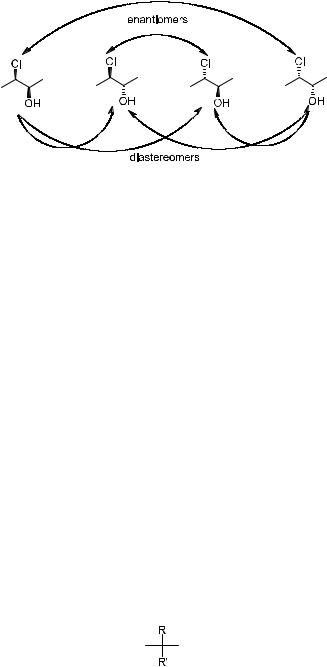
1.2 ASYMMETRY 9
Figure 1±4. Enantiomers and diastereomers.
in having di¨erent con®gurations at one or more chiral centers in the molecule. These substances are called diastereomers. Thus, for 2-chloro-3-hydroxylbutane, one can draw four di¨erent structures, among which one can ®nd two pairs of enantiomeric and four pairs of diastereomeric relations (Fig. 1±4).
For the unambiguous description of the various isomers, it is clearly necessary to have formal rules to de®ne the structural con®gurations. These rules are explained in the following sections.
1.2.2.1 Fischer's Convention. Initially, the absolute con®gurations of optical isomers were unknown to chemists working with optically active compounds. Emil Fischer, the father of carbohydrate chemistry, decided to relate the possible con®gurations of compounds to that of glyceraldehyde of which the absolute con®guration was yet unknown but was de®ned arbitrarily.
In Fischer's projection of glyceraldehyde, the carbon chain is drawn vertically with only the asymmetric carbon in the plane of the paper. Both the carbonyl and the hydroxylmethyl groups are drawn as if they are behind the plane, with the carbonyl group on the top and the hydroxylmethyl group at the bottom of the projection. The hydroxyl group and the hydrogen atom attached to the asymmetric carbon atom are drawn in front of the plane, the hydroxyl group to the right and the hydrogen atom to the left. This con®guration was arbitrarily assigned as the d-con®guration of glyceraldehyde and is identi®ed by a small capital letter d. Its mirror image enantiomer with the opposite con®guration is identi®ed by a small capital letter l.
The structure of any other optically active compound of the type R±CHX±R0 is drawn with the carbon chain
in the vertical direction with the higher oxidative state atom (R or R0) on the top. If the X group (usually ±OH, ±NH2, or a halogen) is on the right side, the relative con®guration is designated d; otherwise the con®guration is designated l.

10 INTRODUCTION
Although the d-form of glyceraldehyde was arbitrarily chosen as the dextrorotatory isomer without any knowledge of its absolute con®guration, the choice was a fortuitous one. In 1951, with the aid of modern analytical methods, the d-con®guration of the dextrorotatory isomer was unambiguously established.
The merit of Fischer's convention is that it enables the systematic stereochemical presentation of a large number of natural products, and this convention is still useful for carbohydrates or amino acids today. Its limitations, however, become obvious with compounds that do not resemble the model reference compound glyceraldehyde. For example, it is very di½cult to correlate the terpene compounds with glyceraldehyde. Furthermore, selection of the correct orientation of the main chain may also be ambiguous. Sometimes different con®gurations may even be assigned to the same compound when the main chain is arranged in a di¨erent way.
1.2.2.2 The Cahn-Ingold-Prelog Convention. The limitations of Fischer's convention made it clear that in order to assign the exact orientation of the four connecting groups around a chiral center it was necessary to establish a systematic nomenclature for stereoisomers. This move started in the 1950s with Cahn, Ingold, and Prelog establishing a new system called the Cahn-Ingold- Prelog (CIP) convention6 for describing stereoisomers. The CIP convention is based on a set of sequence rules, following which the name describing the constitution of a compound is accorded a pre®x that de®nes the absolute con®guration of a molecule unambiguously. These pre®xes also enable the preparation of a stereodrawing that represents the real structure of the molecule.
In the nomenclature system, atoms or groups bonded to the chiral center are prioritized ®rst, based on the sequence rules. The rules can be simpli®ed as follows: (1) An atom having a higher atomic number has priority over one with a lower atomic number; for isotopic atoms, the isotope with a higher mass precedes the one with the lower mass. (2) If two or more of the atoms directly bonded to the asymmetric atom are identical, the atoms attached to them will be compared, according to the same sequence rule. Thus, if there is no heteroatom involved, alkyl groups can be sequenced as tertiary > secondary > primary. When two groups have di¨erent substituents, the substituent bearing the highest atomic number on each group must be compared ®rst. The sequence decision for these groups will be made based on the sequence of the substituents, and the one containing prior substituents has a higher precedence. A similar rule is applicable in the case of groups with heteroatoms. (3) For multiple bonds, a doubly or triply bonded atom is duplicated or triplicated with the atom to which it is connected. This rule is also applicable to aromatic systems. For example,
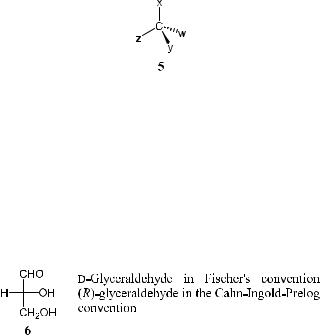
1.2 ASYMMETRY 11
(4) For vinyl groups, a group having the (Z)-con®guration precedes the same group having the (E )-con®guration, and an (R)-group has precedence over an (S)-group for pseudochiral centers.
Based on these sequence rules, con®gurations can be easily assigned to chiral molecules, which are classi®ed into di¨erent types according to spatial orientation. The detailed assignments are as follows.
Central Chirality. The system Cxyzw (5) has no symmetry when x, y, z, and w are di¨erent groups, and this system is referred to as a central chiral system.
Imagine that an asymmetric carbon atom C is connected to w, x, y, and z and that these four substituents are placed in priority sequence x > y > z > w according to the CIP sequencing rule. If we observe the chiral center from a position opposite to group w and from this viewpoint groups x ! y ! z are in clockwise sequence, then this chiral center is de®ned as having an (R)- con®guration.* Otherwise the con®guration is de®ned as (S).y For example, the con®guration of molecule 5 is speci®ed as (R).
Following these rules, d-glyceraldehyde 6 in Fischer's convention can be assigned an (R)-con®guration.
For an adamantane-type compound, it is possible to substitute the four tertiary hydrogen atoms and make four quaternary carbon atoms. These carbon atoms can be asymmetric if the four substituents are chosen properly. It is possible to specify these chiral centers separately, but their chiralities can also be so interlinked that they collectively produce one pair of enantiomers with only one chiral center. Usually it is more convenient to collectively specify the chirality with reference to a center of chirality taken as the unoccupied centroid of the adamantane frame.
* Originating from the Latin word rectus, which means right in English. y Originating from the Latin word sinister, which means left in English.
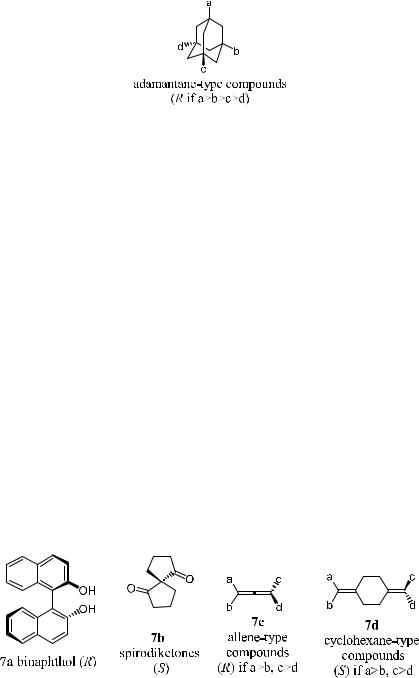
12 INTRODUCTION
Axial Chirality. For a system with four groups arranged out of the plane in pairs about an axis, the system is asymmetric when the groups on each side of the axis are di¨erent. Such a system is referred to as an axial chiral system. This structure can be considered a variant of central chirality. Some axial chiral molecules are allenes, alkylidene cyclohexanes, spiranes, and biaryls (along with their respective isomorphs). For example, compound 7a (binaphthol), which belongs to the class of biaryl-type axial chiral compounds, is extensively used in asymmetric synthesis. Examples of axial chiral compounds are given in Figure 1±5.
The nomenclature for biaryl, allene, or cyclohexane-type compounds follows a similar rule. Viewed along the axis, the nearer pair of ligands receives the ®rst two positions in the order of preference, and the farther ligands take the third and fourth position. The nomination follows a set of rules similar to those applied in the central chiral system. In this nomination, the end from which the molecule is viewed makes no di¨erence. From whichever end it is viewed, the positions remain the same. Thus, compound 7a has an (R)-con®guration irrespective of which end it is viewed from.
It is important to note that the method for naming chiral spirocyclic compounds has been revised from the original proposal.6 In the original nomenclature system, these compounds were treated on the basis of axial chirality like biaryls, allenes, and so forth. According to the old nomenclature, the ®rst and second priorities are given to the prior groups in one cycle, and the third and fourth priorities are given to that in the other one. Taking the above spiro-
Figure 1±5. Some axial chiral compounds.

1.2 ASYMMETRY 13
Figure 1±6. Examples of the old and new nomenclatures of spirocyclic compounds.
diketone 7b as an example, the chiral center, the spiro atom, is bonded to two equivalent carbonyl carbon atoms and two equivalent methylene carbon atoms (Fig. 1±6). In the new nomenclature, the ®rst member of the sequence is given to either one of the carbonyl atoms, and the second priority is given to the other carbonyl carbon (in the old nomenclature, the second priority is given to the methylene atom staying on the same side of the ®rst carbonyl group); the third priority is given to the methylene carbon atom on the same ring side with the ®rst carbonyl group. Thus, the chiral center (the spiro atom of 7b) has con®g- uration (S). If the obsolete, original method were used, the con®guration of 7b would have been designated (R).
Planar Chirality. Planar chirality arises from the desymmetrization of a symmetric plane in such a way that chirality depends on a distinction between the two sides of the plane and on the pattern of the three determining groups. In the de®nition of this chiral system, the ®rst step is the selection of a chiral plane; the second step is to identify a preferred side of the plane. The chiral plane is the plane that contains the highest number of atoms in the molecule.
After the designation of the chiral plane, one then needs to ®nd a descriptor or ``pilot'' atom. To ®nd this atom, one views from the out-of-plane atom closest to the chiral plane. If there are two such atoms, the one closest to the atom of higher precedence in the chiral plane is selected. The leading atom, or ``pilot'' atom, marks the preferred side of the plane. The higher priority atom of the set bonded to the pilot atom is marked as No. 1 as in 8a. The second priority (marked as No. 2) is given to the atom on the chiral plane directly bonded to group No. 1, and so on. Viewing from the preferred side, the designation pR is given to a clockwise orientation of 1 ! 2 ! 3, and pS represents a counterclockwise orientation of these three atoms/groups. Thus, examples 8a and 8b depict a pS-con®guration. The letter ``p'' indicates the planar chirality. In example 8c, a metallocene compound, the compound can be treated as having chiral centers by replacing the h6 ±p bond by six s single bonds (8d ). According to the CIP rules, the chirality of this molecule can then be assigned by examining the most preferred atom on the ring (marked by an arrow). Such a molecule can then be treated as a central chiral system. Thus, according to the rule for central chirality, compound 8c can be assigned an (S)-con®guration.
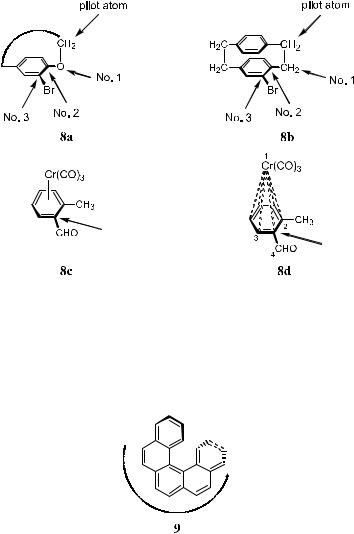
14 INTRODUCTION
Helical Chirality. Helicity is a special case of chirality in which molecules are shaped as a rightor left-handed spiral like a screw or spiral stairs. The con®g- urations are designed M and P, respectively, according to the helical direction. Viewed from the top of the axis, a clockwise helix is de®ned as P, whereas a counterclockwise orientation is de®ned as M. Thus, the con®guration of example 9 is de®ned as M.
Octahedral Structures. Extension of the sequence rule makes it possible to arrange an octahedral structure in such a way that the ligands are placed octahedrally in an order of preference.
Special sequencing rules are applied for assigning the six substituents. Number 1 is given to the group with the highest priority according to the general CIP rule. Number 6 is then located trans to this group regardless of its precedence. (If the choice for No. 1 is open, No. 6 is given to the group with lowest priority, and No. 1 is the one trans to No. 6). The 2, 3, 4, and 5 are located in a plane and form a cyclic sequence. Number 2 will normally be assigned to the more prior group among the four.
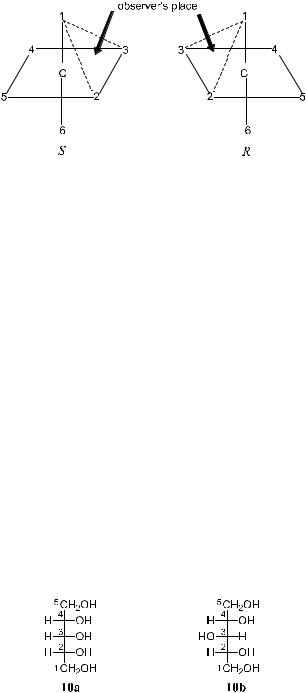
1.2 ASYMMETRY 15
Figure 1±7. Octahedral structures.
The observer looks at the face formed by the ®rst three preferred atoms/ groups (1, 2, and 3) from a direction opposite to the face of 4, 5, and 6. (R)- con®guration is then de®ned as a clockwise arrangement of the groups 1, 2, and 3, and (S)-con®guration is de®ned as a counterclockwise arrangement of the ®rst three preferred groups (Fig. 1±7).
Pseudochiral Centers. A Cabcd system is called a pseudochiral center when a/b are one pair of enantiomeric groups and c/d are di¨erent from a/b as well as di¨erent from each other. Molecules with a pseudochiral center can be either achiral or chiral, depending on the properties of c and d. If both c and d are achiral, the whole molecule is also achiral; if either or both of them is chiral, the molecule is also chiral. As for the sequence rule, R > S is applied when naming the pseudochiral center. The pseudochiral center is noted in italic lowercase r or s. For example, compounds 10a and 10b are the reduction products of d-…ÿ†-ribose and d-…‡†-xylose, respectively (Fig. 1±8). The C2 atom in these two compounds has an (R)-con®guration, and the C4 in these two compounds has an (S)-con®guration. The C3 atoms in these compounds can be considered as pseudochiral centers. C3 in compound 10a is de®ned as s, and C3 in compound 10b is de®ned as r.
Molecules that belong to Cn or Dn point groups are also chiral. For instance, trans-2,5-dimethylpyrrolidine (Fig. 1±9), containing a twofold rotation axis, belongs to the point group C2 and is chiral.7
Figure 1±8. Pseudochiral centers.

16 INTRODUCTION
Figure 1±9. trans-2,5-Dimethylpyrrolidine.
1.3DETERMINING ENANTIOMER COMPOSITION
As mentioned in Section 1.2, the presence of an asymmetric carbon is neither a necessary nor a su½cient condition for optical activity. Each enantiomer of a chiral molecule rotates the plane of polarized light to an equal degree but in opposite directions. A chiral compound is optically active only if the amount of one enantiomer is in excess of the other. Measuring the enantiomer composition is very important in asymmetric synthesis, as chemists working in this area need the information to evaluate the asymmetric induction e½ciency* of asymmetric reactions.
The enantiomer composition of a sample may be described by the enantiomer excess (ee), which describes the excess of one enantiomer over the other:
ee ˆ ‰SŠ ÿ ‰RŠ 100% ‰SŠ ‡ ‰RŠ
where ‰RŠ and ‰SŠ are the composition of R and S enantiomers, respectively. Correspondingly, the diastereomer composition of a sample can be described
by the diastereomer excess (de), which refers to the excess of one diastereomer over the other:
|
‰ |
Š ‡ ‰ |
S R |
Š |
|
||
|
|
|
S S |
|
|
|
|
de ˆ |
|
‰ Š ÿ ‰ Š |
|
100% |
|||
S S S R |
|||||||
|
|
|
|
|
|
|
|
where ‰S SŠ and ‰S RŠ are the composition of the diastereomers, respectively. Di¨erent methods have been developed for determining the enantiomer
compositions of a pair of enantiomers. Some apply measurements of the original molecules, while others use derivatives of the corresponding compounds.
To determine how much one isomer is in excess over the other, analytical methods based on high-performance liquid chromatography (HPLC) or gas chromatography (GC) on a chiral column have proved to be most reliable.
* The goal of an asymmetric reaction is to obtain one enantiomer in high excess of the other. For this reason, after the reaction one has to measure the enantiomer excess. The larger the excess of one enantiomer over the other, the better the result of the asymmetric reaction or the higher e½ciency of the asymmetric induction.

1.3 DETERMINING ENANTIOMER COMPOSITION |
17 |
Chiral chemical shift reagents for NMR analysis are also useful, and so are optical methods.
A variety of methods are also available when the compound under investigation can be converted with a chiral reagent to diastereomeric products, which have readily detectable di¨erences in physical properties. If a derivatizing agent is employed, it must be ensured that the reaction with the subject molecule is quantitative and that the derivatization reaction is carried out to completion. This will ensure that unintentional kinetic resolution does not occur before the analysis. The derivatizing agent itself must be enantiomerically pure, and epimerization should not occur during the entire process of analysis.
1.3.1Measuring Specific Rotation
One of the terms for describing enantiomer composition is optical purity. It refers to the ratio of observed speci®c rotation to the maximum or absolute speci®c rotation of a pure enantiomer sample. For any compound for which the optical rotation of its pure enantiomer is known, the ee value may be determined directly from the observed optical rotation.
‰aŠD20 ˆ L‰aŠ c 100
where ‰aŠ is the measured rotation; L is the path length of cell (dm); c is concentration (g/100 ml); D is the D line of sodium, the wave length of light used
Ê
for measurement (5983 A); and 20 is the temperature in degrees (Celsius).
Optical purity…%† ˆ ‰aŠobs:=‰aŠmax 100%
The classic method of determining the optical purity of a sample is to use a polarimeter. However, this method can be used to determine enantiomeric purity only when the readings are taken carefully with a homogenous sample under speci®c conditions. The method provides comparatively fast but, in many cases, not very precise results. There are several drawbacks to this method: (1) One must have knowledge of the speci®c rotation of the pure enantiomer under the experimental conditions in order to compare it with the measured result from the sample. (2) The measurement of optical rotation may be a¨ected by numerous factors, such as the wavelength of the polarized light, the presence or absence of solvent, the solvent used for the measurement, the concentration of the solution, the temperature of measurement, and so forth. Most importantly, the measurement may be a¨ected signi®cantly by the presence of impurities that have large speci®c rotations. (3) Usually a large quantity of sample is needed, and the optical rotation of the product must be large enough for accurate measurement. (This problem, however, has somewhat been alleviated by advances in instrumentation, such as the availability of the capillary cell.) (4) In
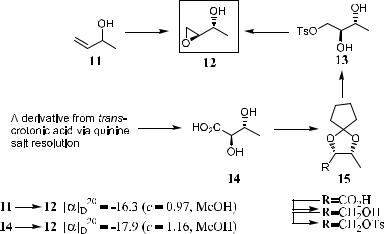
18 INTRODUCTION
Scheme 1±2
the process of obtaining a chemically pure sample for measurement, an enrichment of the major enantiomer may occur and cause substantial errors.
An example of the application of this method is given in Scheme 1±2. White et al.8 reported the enantioselective epoxidation of 3-buten-2-ol (11) using Sharpless reagent (TBHP/Ti(OPri)4/DET, used for the asymmetric epoxidation of allyl alcohols), giving (2S,3R)-1,2-epoxy-3-butanol …ÿ†-12 (‰aŠD20 ˆ ÿ16:3, c ˆ 0:97, MeOH), which was employed in the chiral synthesis of 2,5-dideoxyribose, a segment of the ionophoric antibiotic boromycin. Although the (3R)-enantiomer of 12 was the expected product, an unambiguous proof of the stereochemistry was still necessary. To this end, …G†-erythro-2,3- dihydroxybutyric acid (14), which has been prepared by the hydroxylation of trans-crotonic acid, was resolved via its quinine salt.9 Comparing the speci®c rotations con®rmed that …ÿ†-14 possesses (2S,3R)-con®guration. The protection of …ÿ†-14 as its ketal derivative with cyclopentanone, followed by LAH reduction and tosylation, produced compound 15, which, upon the removal of the cyclopentylidene residue, gave the diol 13. Treatment of 13 with sodium hydride produced 12 (‰aŠD20 ˆ ÿ17:9, c ˆ 1:16, MeOH), which had the same direction of optical rotation as the compound obtained from 11. Based on this result, it was ascertained that the asymmetric epoxidation of 11 a¨orded (2S,3R)- epoxy alcohol 12 with an enantiomer excess of 91% (16.3/17.9 100%).
Example showing the potential for errors in using the optical rotation method that was found in the reduction of enantiomerically pure l-leucine to leucinol using di¨erent reducing agents.10 When borane-dimethylsul®de was used, the product obtained had a speci®c rotation of ‰aŠD20 ˆ ‡4:89 (neat). When NaBH4 or LiAlH4 was used in the reduction of leucine ethyl ester hydrochloride, the leucinol obtained had a speci®c rotation of ‰aŠD20 ˆ ‡1:22 to 1.23. At ®rst, it was thought that racemization had occurred during the reaction
